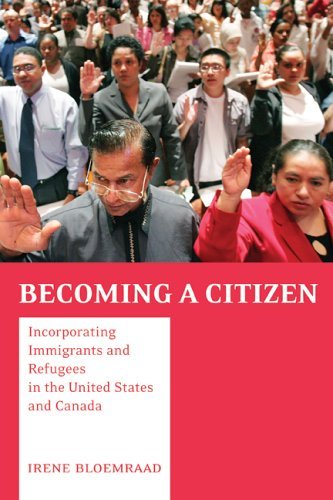Becoming a Citizen: Incorporating Immigrants and Refugees in the United States and Canada
Bloemraad, Irene
Routledge, London
2006
0520248996 (pb)
 Academic explanations of differing levels of immigrant political incorporation frequently centre on the cultural and socio-economic characteristics of the immigrant groups themselves. In her compelling comparative analysis of the political incorporation of immigrants and refugees in Canada and the United States, Irene Bloemraad shifts the focus from the integration mechanisms of immigrant groups to the institutional context and policies of the countries that accept them. If immigrants in the United States can participate politically and acquire citizenship as freely as their counterparts in Canada, why 'are citizenship levels and measures of political success consistently lower in the United States than in Canada?' (p.102). Drawing on census and survey data and 151 interviews with immigrants, community leaders, and government professionals with close ties to these communities, Bloemraad finds that Canada's stronger immigrant-centred multiculturalist policies translate into significantly higher levels of political incorporation, as measured by the significantly higher percentage of immigrants in Canada who are naturalized and elected to public office in comparison to the United States. Her decision to measure political incorporation through a comparison of levels of naturalization and foreign born immigrants running for and winning elected office stems in part from the lack of available comparative data on immigrant voting behaviour. She argues that running for elected office is an extreme but revealing indicator of political integration given that it can reflect not only opportunities for leadership and advocacy development but also levels of participation and support from the immigrant community.
Academic explanations of differing levels of immigrant political incorporation frequently centre on the cultural and socio-economic characteristics of the immigrant groups themselves. In her compelling comparative analysis of the political incorporation of immigrants and refugees in Canada and the United States, Irene Bloemraad shifts the focus from the integration mechanisms of immigrant groups to the institutional context and policies of the countries that accept them. If immigrants in the United States can participate politically and acquire citizenship as freely as their counterparts in Canada, why 'are citizenship levels and measures of political success consistently lower in the United States than in Canada?' (p.102). Drawing on census and survey data and 151 interviews with immigrants, community leaders, and government professionals with close ties to these communities, Bloemraad finds that Canada's stronger immigrant-centred multiculturalist policies translate into significantly higher levels of political incorporation, as measured by the significantly higher percentage of immigrants in Canada who are naturalized and elected to public office in comparison to the United States. Her decision to measure political incorporation through a comparison of levels of naturalization and foreign born immigrants running for and winning elected office stems in part from the lack of available comparative data on immigrant voting behaviour. She argues that running for elected office is an extreme but revealing indicator of political integration given that it can reflect not only opportunities for leadership and advocacy development but also levels of participation and support from the immigrant community.
Bloemraad controls for cross national differences and mitigates problems associated with differing tendencies to naturalize and participate by studying two newcomer groups (Portuguese and Vietnamese) who share similar levels of education, language barriers, and levels of political distrust. As refugees, the Vietnamese have substantially more resources available to them in both countries, yet the broad cross-national differences in political incorporation hold. Bloemraad's thorough analysis shows that neither national differences in citizenship law, immigration policy, political culture, public opinion or party politics account for the differing levels of political incorporation in Canada and the United States. Instead she makes a strong argument that 'the different levels of government support for immigrant settlement, including citizenship activities, and the official promotion of multiple identities and attachments as reflected in support for multiculturalism' is the key to explaining the variance in levels of political incorporation (p.105). Bloemraad examines the impact of specific forms of government intervention on political incorporation. She argues that while political incorporation is a social process rooted in the immigrant communities, the material and symbolic resources provided to those communities by government ultimately have a significant impact on how immigrants understand citizenship and the opportunities available to them for political participation. Government support is key to the development of the local community networks that work to politically incorporate newcomers: communities that receive more resources 'develop more numerous and diverse community organizations' (p.15). This in turn affects opportunities for leadership in the immigrant communities including the ability to run for and win elected office.
Bloemraad's work engages with the debate on multiculturalism and contrasts the laissez faire U.S. model of political incorporation with Canada's greater emphasis on pro-active multicultural policies. In response to those who fear that multiculturalist policies foster ethnic identities at the expense of a common national identity, Bloemraad convincingly argues that in fact policies that promote and recognize specific ethnic, as opposed to racial, identities, actually promote a greater sense of commitment to a common national identity and citizenship. In her concluding chapter Bloemraad reflects on the implications of her findings for countries beyond Canada and the United States and concludes that 'political incorporation is better served when governments extend a welcoming hand: offering concrete settlement assistance and recognizing immigrants' diverse identities, ethnicities, and cultures within a framework of future citizens rather than foreigner or alien' (p.251).
This excellent book should be of interest to those concerned with the problem of creating social and civic cohesion in ethnically and racially diverse nations and will provoke reflection among those involved in the debate over multiculturalism, regardless of where they currently stand.
Cristina Flesher Fominaya
Universidad Carlos III de Madrid, Spain

